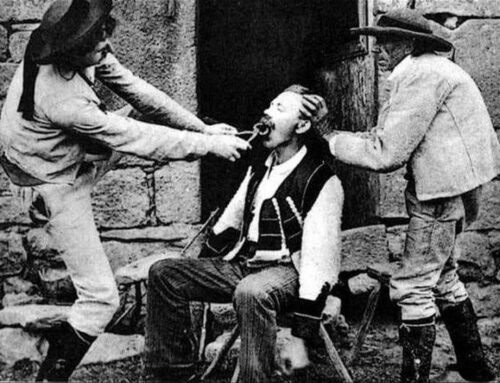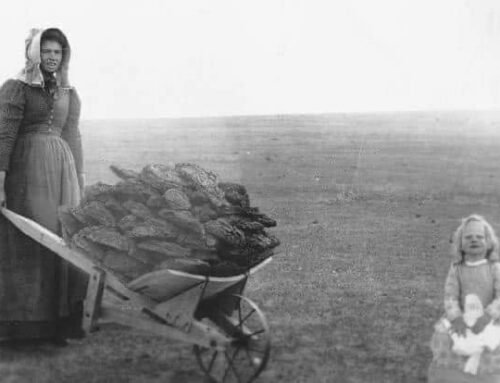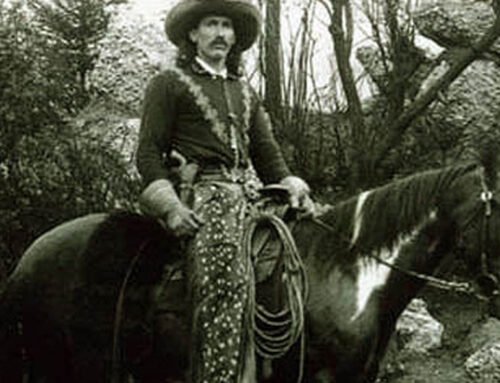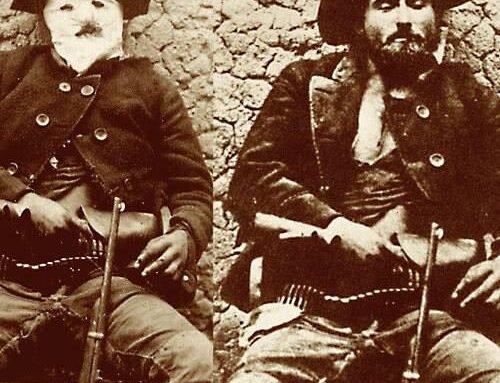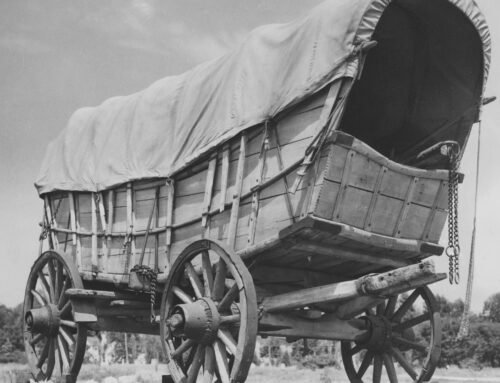Al Swearengen and his Gem Theater
By western author Nick Brumby
 “Harrowing tales of iniquity, shame, and wretchedness; of lives wrecked and fortunes sacrificed; of vice unhindered and esteem forfeited, have been related of the place, and it is known of a verity that they have not all been groundless.”
“Harrowing tales of iniquity, shame, and wretchedness; of lives wrecked and fortunes sacrificed; of vice unhindered and esteem forfeited, have been related of the place, and it is known of a verity that they have not all been groundless.”
–Black Hills Daily Pioneer article about Al Swearingen’s notorious Gem Theater, after it burned down for the third and final time.
Pimp, pioneer, entrepreneur, Old West legend. Al Swearengen was all these and more.
One of the most ruthless, violent and outrageous characters ever to grace the American Frontier, Swearengen thrived in the lawless streets of Deadwood, South Dakota. For twenty-two years, Swearengen’s Gem Theater was one of the most popular entertainment venues (brothels) in Deadwood.
Today, all traces of his pride and joy, the Gem, have disappeared. However, despite (or perhaps due to) his shady dealings, violent temper and willingness to go to any lengths to prevail, Swearengen carved himself a place in the folklore of the West which has stood the test of time.

Ellis Alfred “Al” Swearingen and his twin brother Lemuel were born in Oskaloosa, Iowa, in 1845. The twins were the oldest of eight children.
Swearengen remained at home well into his adult years and only arrived in Deadwood in May 1876 as one of the earliest non-mining men in the area. He was no slouch – by the end of the week, he had a temporary dance hall up and running.
He soon replaced this establishment with a permanent building called the Cricket Saloon, a tiny tavern referred to as a “hall” due to its narrow width. The main entertainment was prize fights. In true Swearengen fashion, not only were prizes not offered, but the matches were not between professionals but were generally between ordinary working miners who Swearingen persuaded to participate for free.
 In 1877 Swearingen opened the Gem Variety Theater, described by the Black Hills Daily Pioneer as being “neat and tastefully arranged as any place of its kind in the west.” Along with prize fights, Gem also offered comedians, singers, and dancers. However, there was no hiding the Gem Theater’s main purpose – as Deadwood’s most famous brothel.
In 1877 Swearingen opened the Gem Variety Theater, described by the Black Hills Daily Pioneer as being “neat and tastefully arranged as any place of its kind in the west.” Along with prize fights, Gem also offered comedians, singers, and dancers. However, there was no hiding the Gem Theater’s main purpose – as Deadwood’s most famous brothel.
The Gem soon gained a reputation for debasing the women who were pressed into service there. Swearengen’s favored tactic for recruiting his unwilling new employees as ‘soiled doves’ was by offering desperate women a pre-paid one-way trip to be hired for ‘legitimate’ stage, cleaning, or waitressing jobs in his theatre. When they arrived, he forced them to work as prostitutes.to repay their debt to him.
Swearengen was ruthless. Those who resisted were first threatened with demands for repayment of the one-way ticket, then threatened with beatings, and finally they were beaten and physically forced to submit to Swearengen’s demands.
Many women refused to give in, but those who escaped found themselves penniless, with no source of income, and alone and vulnerable in a rough and rowdy mining town. Many grew sick and died from lack of proper nutrition and shelter, while others committed suicide.
On one occasion Calamity Jane, who was one of Swearengen’s first dancers at the Gem, procured 10 girls from Sidney, Nebraska for him.
 The Gem prospered and soon became the camp’s chief attraction. Drawing its support from many so-called leading citizens, the saloon was left alone by the authorities.
The Gem prospered and soon became the camp’s chief attraction. Drawing its support from many so-called leading citizens, the saloon was left alone by the authorities.
In the front of the theater were a bar and seating for spectators. The rear of the building held several small curtained rooms where the Gem’s “painted ladies” entertained their customers. Once inside, the women charged their customers 10¢ for a dance, 20¢ for a beer, and $1 for a bottle of wine.
The results were highly lucrative: the Gem earned a nightly average of $5000, and sometimes as much as $10,000 per night (equivalent to $254,000 in 2021).
However the violence in Swearengen’s pride and joy was not confined to the employees. Though a popular spot amongst the rowdy miners of the camp, the Gem quickly gained a reputation as a violent saloon where gunshots flying through its interior became commonplace.
In one memorable instance, a soiled dove named ‘Trixie’ shot a man through the front of his skull after being beaten by him. However, the man didn’t immediately die. The attending doctor put a probe through the man’s head, amazed that he survived the gunshot at all. He died about 30 minutes later.
Early summer of 1879, the Gem suffered a fire, but the damage was quickly repaired and rebuilt. Just three months later, in September 1879, the entire town of Deadwood suffered a disastrous inferno that claimed 300 of its buildings, including the Gem.
Swearingen again rebuilt, this time from the ground up, resulting in a bigger and better theater. When the new Gem was opened in December 1879, The Daily Times touted it to be the finest theater building ever proposed for Deadwood.
 The Gem continued to prosper, but Swearingen’s luck would not last. In 1899, the Gem suffered its final destructive fire. When firefighters arrived at the scene they discovered that someone had stolen the hydrant wrenches. All they could do was watch the building burn. After the third fire, Swearingen called it quits, leaving Deadwood for good.
The Gem continued to prosper, but Swearingen’s luck would not last. In 1899, the Gem suffered its final destructive fire. When firefighters arrived at the scene they discovered that someone had stolen the hydrant wrenches. All they could do was watch the building burn. After the third fire, Swearingen called it quits, leaving Deadwood for good.
Swearengen died on November 15, 1904, near the Denver & Rio Grande railroad tracks where they cross Alameda Avenue in Denver.
The coroner’s report said that a passerby found Swearengen. No one saw him die, but his injuries were extensive – his skull was fractured, his ribs on the right side were broken, and both his legs were badly crushed.
The coroner said Swearengen was a miner and supposed to be going up to the mountains. According to his report, he had nothing of value other than a cheap watch, knife, and dynamite fuse and cap for his mining work.
It was the end of an era. The 59-year-old’s body was returned to his family for burial.
Interestingly, Swearengen’s twin brother was shot by unknown assailants just two months prior to his own death. Many believe Swearengen was the intended target but the assailants shot his brother by mistake.

About Nick Brumby
I like a good story. And of all stories, I love westerns the most.
As a kid, I spent far too many afternoons re-watching Clint Eastwood spaghetti westerns, picking up ‘Shane’ for just one more read, or saddling up beside Ben Cartwright when ‘Bonanza’ was on TV each afternoon.
I’m a former journalist and I love horses, dogs, and the occasional bourbon whiskey. I live with my wife, daughter and our ever-slumbering hound in a 1800’s-era gold mining town – our house is right on top of the last working gold mine in the area. There may not be much gold left, but there’s history wherever you look.
I hope you enjoy my westerns as much as I enjoyed writing them!
Happy trails,
Nick






















